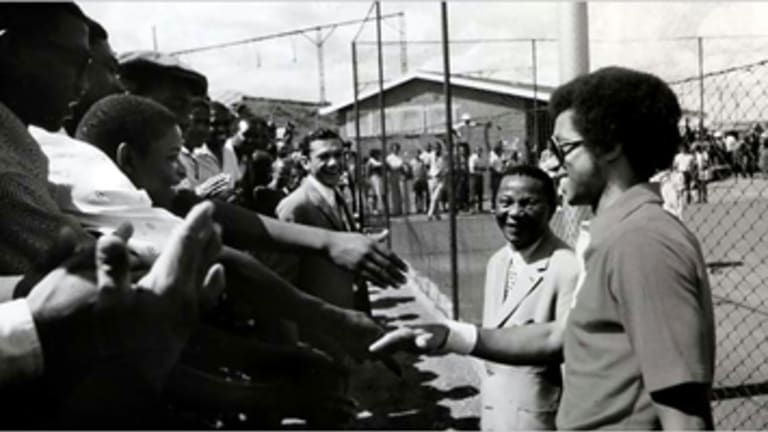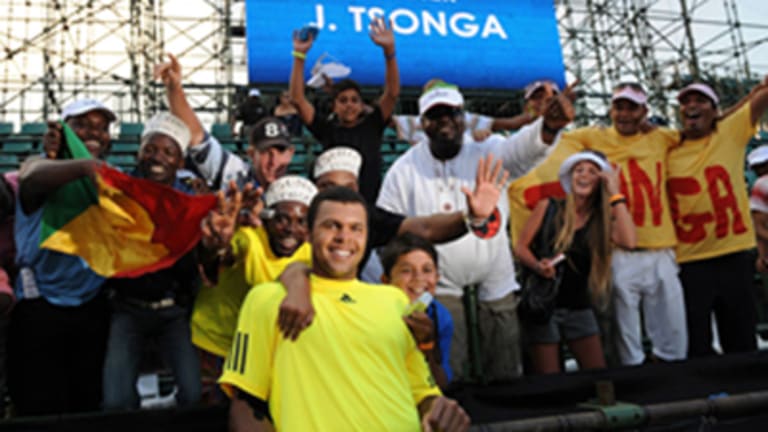The more things change, the more they stay the same, right? Maybe the new phrase should be: The more things change, the less we notice.
Before this week is over and we turn our attention to Rotterdam and Paris, let me take a minute to note that on Sunday, a black tennis player, Jo-Wilfried Tsonga, won the South African Open in Johannesburg.
My first reaction to that news was something along the lines of, “Maybe Tsonga can keep up his momentum this year.” But looking at the photos from the post-final trophy ceremony, where he posed with local fans, it struck me that not long ago his win would have been (1) of incredible political significance, and (2) impossible.
This was the first year that an ATP event has been held in South Africa since 1995. Before that, “Jo-burg” had been a staple of the tour for decades, a regular stop—there were two tournaments in the city each year in the 70s—in one of the traditional Anglo hotbeds of the sport. After scouring the ATP archives, I believe Tsonga is the first black player to win the tournament. (Which isn’t too surprising, since none entered it until 1973.) But I didn't see that mentioned in any of the reports on his win.
In '73, Arthur Ashe made a deal with South Africa’s apartheid government to be allowed into the draw. He had first tried to enter it in 1970 and was denied, which led him to call for SA’s ouster from the ITF, and for other nations to boycott Davis Cup ties against the country. That eventually led to South Africa winning the Cup by default over India in 1974, a low point in the competition’s history, but a high point for political commitment in sports.
Four years after his inital attempt, Ashe finally made the trip to Jo-Burg. He was criticized from both sides for playing the tournament. As Cliff Drysdale, an opponent of apartheid and friend of Ashe, said at the time, there were those in SA who thought the whole thing had to end in violence anyway, and that by coming there Ashe was actually making the government look humane and prolonging the inevitable (Drysdale himself didn’t buy this argument). On the other side was Bob Hewitt, a great South African doubles player, who thought Ashe should mind his own business, because the blacks in his country were “happy.” Ashe went anyway, determined to see the system for himself and to show blacks there what one of their own could do if given the chance.
Ashe’s trip was a sensation in the country, to the point where it surprised even him. (For the on-the-ground report, read Frank DeFord’s great Sports Illustrated article about it from that time.) Ashe was nicknamed “Sipho” in the black township of Soweto, meaning “a gift.” His matches were mini-Super Bowls, where he was cheered by black and white alike (he had forced the tournament’s promoter to allow blacks to sit anywhere in the stadium; normally, apartheid was enforced at sporting events like anywhere else). One day Ashe found himself being followed by a young black man. When Ashe asked him what he wanted, he said that he’d never seen a free black person before. Ashe was surprised and moved by the statement. As the week went on, he noticed that his car was being tailed.
Ashe recorded his reactions to the trip in his 1975 book with DeFord, Portrait in Motion. Like his fellow amateur era tennis player-scribe, Gordon Forbes, Ashe proved to be one of the most thoughtful athletes you’ll ever read. In its searching quality and calm perceptiveness, the book has parallels to Barack Obama’s Dreams From My Father, which ends with his own trip to Africa. Ashe’s descriptions are notable for their depth and intelligence, but also for their lack of political ponderousness. He says that he was almost happy to see “Whites Only” signs on public restrooms in South Africa, because not seeing them in that country would have been like not seeing the Eiffel Tower on a trip to Paris. But he also ends with a chilling conversation with a group of whites who continually vote for apartheid candidates. The easy life that the system affords them is so hard to give up, its artifice so hard to confront, that it leads them to justify it by telling themselves that blacks are “children” who need to be taken care of.
The SA Open was an eventful tournament on court for Ashe as well. In an early round, he beat Drysdale and sensed that the whites in the crowd were rooting for him, and against their home-country favorite, because Cliff was a critic of apartheid. In the final Ashe faced—who else?—Jimmy Connors, the all-purpose tennis villain of the era. Connors, the punk kid in his second year on tour, took out Ashe in straight sets. As DeFord says, by the third set the crowd was completely silent as it saw that its hero was going to be outmatched on this day.

